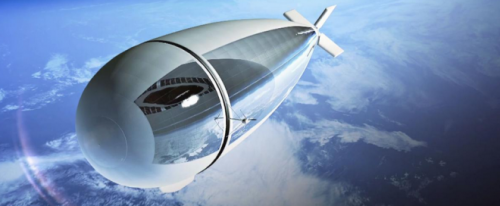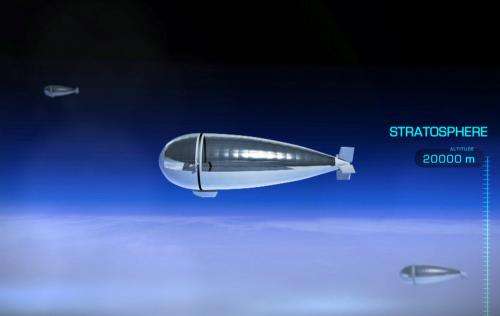Credit: Thales
(Phys.org) —A project that presents a concept of something between drone and satellite is under way. The vehicle is called StratoBus, developed in Europe. The StratoBus will be able to carry out missions such as border and maritime surveillance, telecommunications, broadcasting and navigation. Potential applications include boosting GSM network capacity for public events and GPS augmentation over dense traffic areas. The shell fabric is made of braided carbon fiber. The StratoBus will be able to carry payloads up to 200 kg. The first prototype is planned for rollout within the next five years. StratoBus is described as an autonomous stationary platform and the company emphasized its two notable features, the ability to carry out long endurance observation and complete autonomy from a fixed position.
The StratoBus project is led by Thales Alenia Space, which is focused on space telecommunications and navigation. "We design, integrate, test and operate high-performance satellite technologies in both civil and defense sectors," according to the company notes. Airbus Defence & Space, Zodiac Marine and CEA-Liten are partners. The project is part of the creation of an airship company by the Pégase competitiveness cluster in southern France. The Pégase cluster is a network of major players in the aeronautics and space industry of the Provence-Alpes-Côte d'Azur region, pooling those involved with UAVs, balloons and stratospheric aircrafts for specific missions. (The Cote d'Azur is a crossroads in Europe for aerospace research, where there is a network of subcontractors and specialist companies working closely with research laboratories.)
StratoBus will be operating at an altitude of about 20 kilometers, the lower reaches of the stratosphere but above air traffic and jet streams. The airship measures 70 to 100 meters long and 20 to 30 meters in diameter. The company said its design carries "technological innovations," in particular to make sure it captures the sun's rays in all seasons; a power generation system coupling solar panels to a solar power amplification system; and a light reversible fuel cell for energy storage.
The company said the StratoBus platform will require continuous, significant energy input to offset the wind. Two electric motors will automatically adjust their output power depending on wind speed, up to 90 km/h.
More information:
www.thalesgroup.com/en/worldwi … -drone-and-satellite
www.investinpaca.com/files/PEGASE_A.pdf
© 2014 Phys.org

























